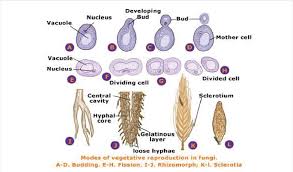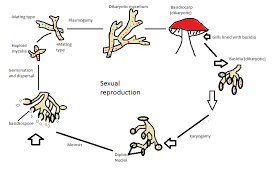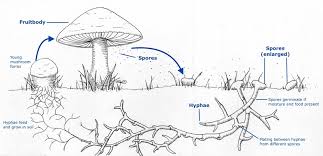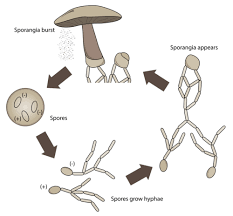The previous article covered fungal morphology. In this article, the process of reproduction in fungi will be explored. Like algae, reproduction in fungi occurs through vegetative, asexual, and sexual methods. The following sections provide descriptions of various types of reproduction in fungi, along with suitable examples.
Types of Reproduction in Fungi
Previously, it was noted that fungal hyphae elongate through apical growth, but most parts of a fungus are capable of growth. When the mycelium of a fungus reaches a certain stage of maturity and accumulates reserve food, it initiates reproduction. As in algae, reproduction in fungi is of three kinds: vegetative, asexual, and sexual.
1. Vegetative Reproduction in Fungi
Vegetative and asexual methods of reproduction, which do not involve the fusion of nuclei, sex cells, or sex organs, are often grouped together by many mycologists under asexual reproduction. Consequently, they recognize only two types of reproduction: asexual and sexual.
2. Asexual Reproduction in Fungi

Asexual reproduction is more common in fungi than sexual reproduction. It typically occurs several times during a season and involves the formation of special reproductive cells called spores.
The formation of spores in fungi is referred to as sporulation. Each spore develops into a new mycelium. These spores are produced through mitosis in the parent cell, which is why they are also known as mitospores. Spores in fungi vary in color, shape, size, number, arrangement on hyphae, and how they are produced.
Spores may range in color from hyaline to shades of green, yellow, orange, red, brown, and black, and vary in size from minute to large. In shape, they can range from globose to oval, oblong, needle-shaped, or even helical. The diversity of spores in fungi is fascinating when observed under a microscope.
Typically, fungal spores are unicellular, and they may be uninucleate or multinucleate. However, in some fungi, such as Alternaria and Curvularia, the spores are multicellular.
Types of Mitospores Produced in Fungi
There are two types of mitospores produced in fungi: sporangiospores and conidia.
1. Sporangiospores in Fungi: Sporangiospores are produced inside a sac-like structure called a sporangium. The hypha that bears the sporangium is called a sporangiophore, which is characteristically branched. Sporangiospores may be motile or non-motile.
The non-motile sporangiospores are called aplanospores, from the Greek “a,” meaning “not,” and “planets,” meaning “wanderer.” These are characteristic of terrestrial species like Mucor and Rhizopus. In aquatic fungi, such as Pythium of the Division Oomycota, motile biflagellate sporangiospores are produced, which are known as zoospores. The sporangium bearing these spores is referred to as a zoosporangium.
Zoospores are motile spores that lack a cell wall. After a swarming period, they secrete a wall and germinate to form a germ tube. In contrast, aplanospores possess a defined spore wall and are dispersed by wind and insects.
2. Conidia in Fungi: Conidia are non-motile, deciduous mitospores formed externally as single, separate cells. They develop either directly on the mycelium or on specialized hyphae known as conidiophores.
Conidiophores can be simple or branched, septate or aseptate. Conidia are produced singly, as in Phytophthora, or in chains at the tips of conidiophores, as in Aspergillus, or at the tips of their branches, as in Penicillium.
In many cases, conidiophores arise singly and are scattered throughout the mycelium. Occasionally, they arise in specialized structures known as fruiting bodies. Depending on their appearance, these fruiting bodies are termed synnema, sporodochia, acervuli (saucer-shaped), pycnidia (flask-shaped or globular), or pustules.
Read Also: Recommended Volume of Water for Fish Farming on a Concrete Pond
3. Sexual Reproduction in Fungi

The sexual stage in fungi is referred to as the perfect state, in contrast to the imperfect state, which is the asexual stage. Sexual reproduction involves the fusion of two compatible sex cells or gametes of opposite strains. Fungal sex organs are called gametangia.
They may be of equal size, but in many higher ascomycetes, morphologically distinct gametangia are formed. The male gametangia are called antheridia, while the female ones are called ascogonia.
Fungi may be homothallic, meaning the fusing gametes come from the same mycelium, or heterothallic, where the fusing gametes originate from different strains of mycelia. Sexual reproduction in fungi involves the following three phases:
i) plasmogamy,
ii) karyogamy,
iii) meiosis.
These three processes occur in sequence and at specific stages during the sexual cycle of each species.
Phases of Sexual Reproduction in Fungi
1. Plasmogamy: This is the fusion of protoplasts from reproductive hyphae or cells—one from the male and the other from the female bringing the nuclei of the two parents close together. However, the nuclei do not immediately fuse, resulting in a dikaryotic cell.
This dikaryotic condition is unique to fungi and can persist for several generations as the two nuclei divide simultaneously during cell division, passing on to daughter hyphae.
2. Karyogamy: This phase involves the fusion of the two nuclei. Karyogamy may occur immediately after plasmogamy in lower fungi or may be delayed for a long period, as seen in higher fungi.
3. Meiosis: Karyogamy, which eventually occurs in all sexually reproducing fungi, is followed by meiosis, producing four genetically distinct spores.
Methods of Plasmogamy in Fungi
i. Planogametic Copulation: This method involves the fusion of two gametes. As seen in algae, sexual union in fungi can be isogamous, anisogamous, or oogamous.
Anisogamy and oogamy are collectively referred to as heterogamous sexual reproduction. Isogamy is the simplest type of sexual reproduction, where the fusing gametes are morphologically similar, as seen in Olpidium and Catenaria.
Anisogamy, where the gametes are dissimilar, is observed in Allomyces, a type of chytrid. In oogamy, the motile antherozoid enters the oogonium and unites with the egg or oosphere to form a zygote, as seen in fungi like Pythium and Albugo.
ii. Gametangial Copulation: In this method, the two gametangia come into contact, and their entire contents fuse, becoming one, as seen in Mucor and Rhizopus. In some fungi, the entire protoplast of one gametangium flows into the other through a pore. The recipient is considered the female, while the donor is the male.
iii. Gametangial Contact: In this process, the male gamete is represented by the nucleus inside the antheridium, which migrates into the oogonium through a contact tube formed between the two. However, the gametangia themselves do not fuse. This type of reproduction is observed in Penicillium.
iv. Spermatization: In this mode of reproduction, small conidia-like gametes, called spermatia, are produced externally on special hyphae known as spermatiophores. Spermatia may develop within cavities called spermatogonia. The female cell can be a gametangium, a specialized receptive hypha, or even a vegetative hypha.
v. Somatogamy: In higher fungi, such as Ascomycetes and Basidiomycetes, there is a progressive simplification of sexual reproduction. This process involves the fusion of two mycelia belonging to opposite strains. Post-fertilization changes result in the production of a fruiting body called an ascocarp in Ascomycetes and a basidiocarp in Basidiomycetes.
Read Also: The Recommended Feeding Levels for Catfish at a Water temperature of 27-28°C
Formation of Fruiting Bodies and Spores in Fungi

The fusion of male and female nuclei results in the formation of diploid nuclei. Following this, reduction division (meiosis) occurs, leading to the formation of haploid spores. In fungi, these spores may be formed in specialized structures that are characteristic of different divisions.
In Ascomycetes, spores, known as ascospores, are produced within sac-like structures called asci. These asci are contained within fruiting bodies known as ascocarps. Ascocarps are categorized based on their shape and structure: cleistothecium (indehiscent), apothecium (cup- or saucer-shaped), perithecium (flask-shaped), and pseudoperithecium.
In Basidiomycetes, sexual spores are termed basidiospores, which develop on a club-shaped structure called a basidium.
In conclusion, fungi reproduce when the mycelium reaches a certain stage of maturity. For instance, Phytophthora infestans, the causal agent of potato blight, reproduces both sexually and asexually, alternating between these phases depending on favorable environmental conditions. Similarly, Rhizopus, another parasitic fungus, follows a life cycle comparable to Phytophthora.
Do you have any questions, suggestions, or contributions? If so, please feel free to use the comment box below to share your thoughts. We also encourage you to kindly share this information with others who might benefit from it. Since we can’t reach everyone at once, we truly appreciate your help in spreading the word. Thank you so much for your support and for sharing!
Read Also: How to Start an Urban Farm

